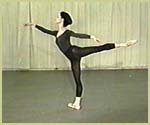
Here is your first Ballet Term of the week.
This is the first exercise we do in our ballet class.

 Plié
Plié[plee-AY]
Bent, bending. A bending of the knee or knees. This is an exercise to render the joints and muscles soft and pliable and the tendons flexible and elastic, and to develop a sense of balance. There are two principal pliés: grand plié or full bending of the knees (the knees should be bent until the thighs are horizontal) and demi-plié or half-bending of the knees. Pliés are done at the bar and in the centre in all five positions of the feet. The third position is usually omitted. When a grand plié is executed in either the first, third or fourth position croisé (feet in the fifth position but separated by the space of one foot) or the fifth position, the heels always rise off the ground and are lowered again as the knees straighten. The bending movement should be gradual and free from jerks, and the knees should be at least half-bent before the heels are allowed to rise. The body should rise at the same speed at which it descended, pressing the heels into the floor. In the grand plié in the second position or the fourth position ouverte (feet in the first position but separated by the space of one foot) the heels do not rise off the ground. All demi-pliés are done without lifting the heels from the ground. In all pliés the legs must be well turned out from the hips, the knees open and well over the toes, and the weight of the body evenly distributed on both feet, with the whole foot grasping the floor.












